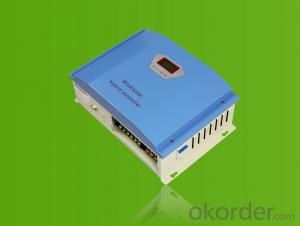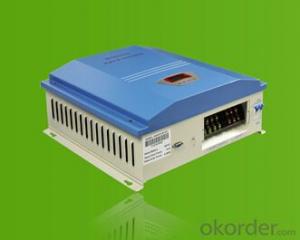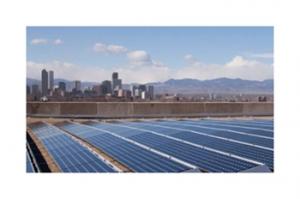Solar Controllers Amazon - Wind Solar Hybrid Controller 3kw PWM Stepless Unload Mode
- Loading Port:
- Shanghai
- Payment Terms:
- TT or LC
- Min Order Qty:
- 1 unit
- Supply Capability:
- 5000 unit/month
OKorder Service Pledge
OKorder Financial Service
You Might Also Like
I. PRODUCT INTRODUCTION
The wind/solar hybrid controller is the control device which can control wind turbine and solar panel at the same time and transform wind and solar energy into electricity then stores to the battery bank.Wind/solar hybrid controller is the most important part in off-grid system, whose performance has much effect on life expectancy and operational stability of the whole system, especially the battery expectancy. Or battery service life will be shortened by over-charge or over-discharge.
II. PERFORMANCE FEATURES
Superior military-grade components to ensure the product stability.
Perfect protection function, thus the system has higher reliability.
Check and set all operation parameters as requirement from LCD display.
Voltage limiting and current-limiting charge mode ensures battery in the best charging status.
PWM stepless unload mode, which burn the excess power into dump load, making the battery charging in best status.
III. APPLICATION AREAS
Stand alone wind/solar hybrid power station; Stand alone domestic household wind/solar hybrid power system.
Mobile communication base stations, expressway and other non-residential regions.
Coastal islands, remote mountainous, border posts for regions shortage of or without electricity.
Government demonstration projects, landscape lighting project.
IV. 3KW TECHNICAL PARAMETERS
Product Model | WWS30-48 | WWS30-96 | WWS30-110 | WWS30-120 | WWS30-220 |
Rated Battery Voltage | 48 V | 96 V | 110V | 120 V | 220 V |
Rated Wind Turbine Input Power | 3 kW | 3 kW | 3kW | 3 kW | 3 kW |
Maximum Wind Turbine Input Power | 4.5 kW | 4.5 kW | 4.5kW | 4.5 kW | 4.5 kW |
Wind Turbine Brake Current | 63 A | 32 A | 28A | 25 A | 14 A |
Rated Solar Input Power | 0.9 kW | 0.9 kW | 0.9kW | 0.9 kW | 0.9 kW |
Floating Charging Voltage | 58 V | 116 V | 133V | 145 V | 266 V |
Dimension(L x W x H) | 442×525×172 mm | ||||
Net Weight | 15kg | ||||
Display Mode | LCD | ||||
Cooling | Fan | ||||
Protection Level | IP20(Indoor) | ||||
Quiescent Current | ≤20 mA | ||||
Protection functions | Battery over charge; Battery over discharge; solar reverse charge protection; anti-reverse-connection protection; wind turbine over rotate speed protection; wind turbine over wind speed protection; wind turbine over voltage protection; wind turbine over current protection; manual brake protection; automatically brake protection; lightning protection. | ||||
Ambient Temperature | -20~+55℃ | ||||
Ambient Humidity | 0~93%, without condensing | ||||
Working humidity | ≤4000m | ||||
In order to serve our customers better. Our company can adjust parameters configuration according to customer’s requirement. | |||||

- Q: How does a solar controller handle voltage fluctuations in the battery?
- A solar controller is designed to handle voltage fluctuations in the battery by regulating and controlling the charging process. When the solar panels generate electricity, the controller monitors the voltage and current output to ensure that it is within the acceptable range for charging the battery. If the voltage from the solar panels is higher than the battery's voltage, the controller will reduce the charging current to prevent overcharging and potential damage to the battery. This is achieved by using a charge regulation algorithm that adjusts the charging current accordingly. Conversely, if the voltage from the solar panels is lower than the battery's voltage, the controller will increase the charging current to compensate for the lower input voltage. This helps to ensure that the battery receives sufficient charging power to reach its optimal voltage level. Additionally, a solar controller may also incorporate a built-in voltage regulator to provide a stable and consistent output voltage to the battery. This regulator helps to smoothen out any fluctuations in the solar panel's voltage output, providing a more reliable and consistent charging current to the battery. Overall, a solar controller plays a vital role in handling voltage fluctuations in the battery by regulating the charging process, preventing overcharging or undercharging, and ensuring that the battery receives the appropriate voltage and current for efficient and safe charging.
- Q: What is the maximum power that a solar controller can handle?
- The maximum power that a solar controller can handle varies depending on the specific model and brand. Generally, they are designed to handle a range of power outputs, typically from a few watts to several kilowatts. It is important to consult the specifications provided by the manufacturer to determine the maximum power capacity of a particular solar controller.
- Q: Can a solar controller be used with a solar-powered warehouse or distribution center?
- Yes, a solar controller can definitely be used with a solar-powered warehouse or distribution center. A solar controller, also known as a charge controller, is an essential component in a solar power system that regulates the flow of electricity from the solar panels to the battery bank. By ensuring that the batteries are charged efficiently and preventing overcharging or damage, a solar controller helps optimize the performance and longevity of the solar power system in a warehouse or distribution center.
- Q: What is the maximum cable length between the solar panels and the solar controller?
- The maximum cable length between the solar panels and the solar controller depends on various factors such as the type of cable used, the voltage drop tolerance, and the specific system requirements. However, in general, it is recommended to keep the cable length between the solar panels and the solar controller as short as possible to minimize power losses due to resistance in the cables.
- Q: Can a solar controller be used with AGM batteries?
- Yes, a solar controller can be used with AGM (Absorbent Glass Mat) batteries. AGM batteries are a type of lead-acid battery and can be charged using a solar controller. The solar controller helps regulate and optimize the charging process, ensuring the AGM batteries receive the appropriate voltage and current from the solar panels.
- Q: Can a solar controller be used for grid-tied solar systems?
- No, a solar controller is not typically used for grid-tied solar systems. Grid-tied solar systems are designed to feed excess energy back into the electrical grid and do not require a controller to regulate the flow of electricity.
- Q: What is the maximum temperature rating for a solar controller?
- The specific model and manufacturer are factors that can cause the maximum temperature rating for a solar controller to differ. Nevertheless, a majority of well-made solar controllers are engineered to function effectively within a broad spectrum of temperatures, typically spanning from -40°C to 85°C (-40°F to 185°F). This wide temperature range guarantees that the controller remains resilient and durable, even in the face of harsh weather conditions like scorching summers or freezing winters. To ascertain the maximum temperature rating for a particular solar controller model, it is imperative to refer to the manufacturer's specifications or user manual.
- Q: Can a solar controller be used with solar panels that are mounted on a pole?
- Yes, a solar controller can be used with solar panels that are mounted on a pole. The solar controller plays a crucial role in regulating the voltage and current flowing between the solar panels and the battery bank. It ensures that the batteries are properly charged and protected from overcharging. Regardless of the mounting location of the solar panels, whether on a pole or any other structure, the solar controller can still be connected to the panels to monitor and control the charging process. The solar controller will analyze the incoming power from the panels and adjust the charging parameters accordingly, maximizing the efficiency and lifespan of the battery system.
- Q: Can a solar controller be used with solar panel pole mounts?
- Yes, a solar controller can be used with solar panel pole mounts. The solar controller is responsible for regulating the charging and discharging of the batteries connected to the solar system. It does not directly interfere with the mounting of the solar panels on the pole.
- Q: Can a solar controller be used with a solar-powered geothermal system?
- No, a solar controller cannot be used with a solar-powered geothermal system as they are two separate and distinct technologies. A solar controller is designed to regulate and control the output of solar panels, whereas a geothermal system utilizes heat from the ground to provide heating and cooling for a building.
Send your message to us
Solar Controllers Amazon - Wind Solar Hybrid Controller 3kw PWM Stepless Unload Mode
- Loading Port:
- Shanghai
- Payment Terms:
- TT or LC
- Min Order Qty:
- 1 unit
- Supply Capability:
- 5000 unit/month
OKorder Service Pledge
OKorder Financial Service
Similar products
Hot products
Hot Searches
Related keywords



























